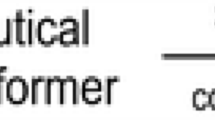Abstract
In previous publications1,2 dealing with the ‘Volatile copper compound’, we reported that the unstable subliming cuprous salts of fatty acids (mainly that of formic acid) gave rise to effects which had been attributed to a copper carbonyl. (Reference was not made to the relevant work of Robinson and Stainthorpe3, as the paper was not accessible to us at that time.) These salts proved to be the intermediate thermal decomposition products of the corresponding cupric salts and also appeared in undefined circumstances where copper-containing materials and decomposing organic substances were heated in contact.
Similar content being viewed by others
References
Keller and Körösy, Nature, 162, 580 (1948).
Keller and Körösy, Magyar Technika, 12, 83 (1948).
Robinson and Stainthorpe, Nature, 153, 24 (1944).
Milrath, Chem. Z., 33, 1259 (1909).
Stolle and Henke-Stark, J. prakt. Chem., (2), 124, 276 (1929).
Jureček and Mužik, Coll. Czecho. Chem. Comm., 15, 236 (1950).
Author information
Authors and Affiliations
Rights and permissions
About this article
Cite this article
KELLER, A. The ‘Volatile Copper Compound’ and its Effect on the Beilstein Test. Nature 167, 907–908 (1951). https://doi.org/10.1038/167907a0
Issue Date:
DOI: https://doi.org/10.1038/167907a0
- Springer Nature Limited





